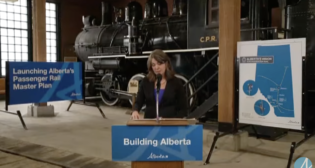
Caltrain electrification costs, timeframe increase
Written by William C. Vantuono, Editor-in-ChiefElectrification costs, originally calculated in 2008 at $1.2 billion, are now projected to be between $1.47 billion and $1.5 billion, an approximately 20% increase. The projected cost for the total Caltrain Modernization (CalMod) Program, originally $1.45 billion, now stands at $1.7 billion to $1.76 billion, also approximately 20% increase. The projected cost of the new signal and train control system, CBOSS PTC, which is part of the CalMod Program, is unchanged at $231 million.
Startup of electrified service has been extended by at least one year, from winter 2019 to between winter 2020 and spring 2021.
The increased costs have been attributed to “inflation, updated industry information, additional engineering and an analysis of the challenges associated with constructing the project while also maintaining train service that continues to see dramatic increases in ridership demand,” Caltrain said. “The range reflects cost containment measures associated with scope reductions and deferments that are under consideration. The last electrification project cost update was prepared in 2008. In 2012, nine local, state, and regional entities agreed to fund the Caltrain Modernization Program. That funding plan was based on the 2008 PCEP cost projections and also included CBOSS PTC. The overall program meets Caltrain’s modernization goals and is an early investment for the state’s high-speed rail system. CBOSS PTC is fully funded and under construction.”
The PCEP environmental process is expected to be complete in January 2015, with construction starting in 2016.
Caltrain said it is “working with its regional, state, and federal funding partners to explore opportunities to secure the additional investment needed to complete the project. Additional funding opportunities include, but are not limited to, California’s cap-and-trade program, FTA’s Vehicle Replacement and Core Capacity programs, a regional bridge toll program, and Caltrain fares. Caltrain financing and/or a TIFIA loan would also help address the funding gap and meet cash flow needs.”
In May, Caltrain started the Request for Qualification process for designing and building the electrification system. Six firms have been pre-qualified to submit bids when the Request for Proposals is issued in early 2015. Those firms include Balfour Beatty Infrastructure; Caltrain Modernization Partners (Elecnor/Cobra Joint Venture); Mass Electric/Siemens Joint Venture; Peninsula Electrification Partners Parsons Transportation Group/Isolux Corsan Joint Venture; Shimmick/Alstom Joint Venture; and Skanska-Comstock-Aldridge Joint Venture. Contractors were required to demonstrate past experience on similar type and value design-build projects to be pre-qualified to submit bids on the design build proposal when it is posted next year.
In May, Caltrain also issued a Request for Information for the procurement of EMUs. The RFI process, which included meetings with suppliers, “provided valuable information about in-service vehicles that meet the needs of Caltrain,” the agency said. “Currently, Caltrain is evaluating feedback from the public on key capacity issues including priorities for seats, standing room, bike storage, and bathrooms. Caltrain is also exploring vehicle options that would support shared platforms with high speed trains in the future and meet the needs of Caltrain riders.
RFPs for both electrification and vehicles are scheduled to be released in early 2015, with contracts to be awarded in late 2015. Caltrain said that while the cost update “has been prepared by experts in the field of electrified systems,” the project’s final cost “will be known when the design-build and vehicle procurement contracts are awarded in 2015.”



